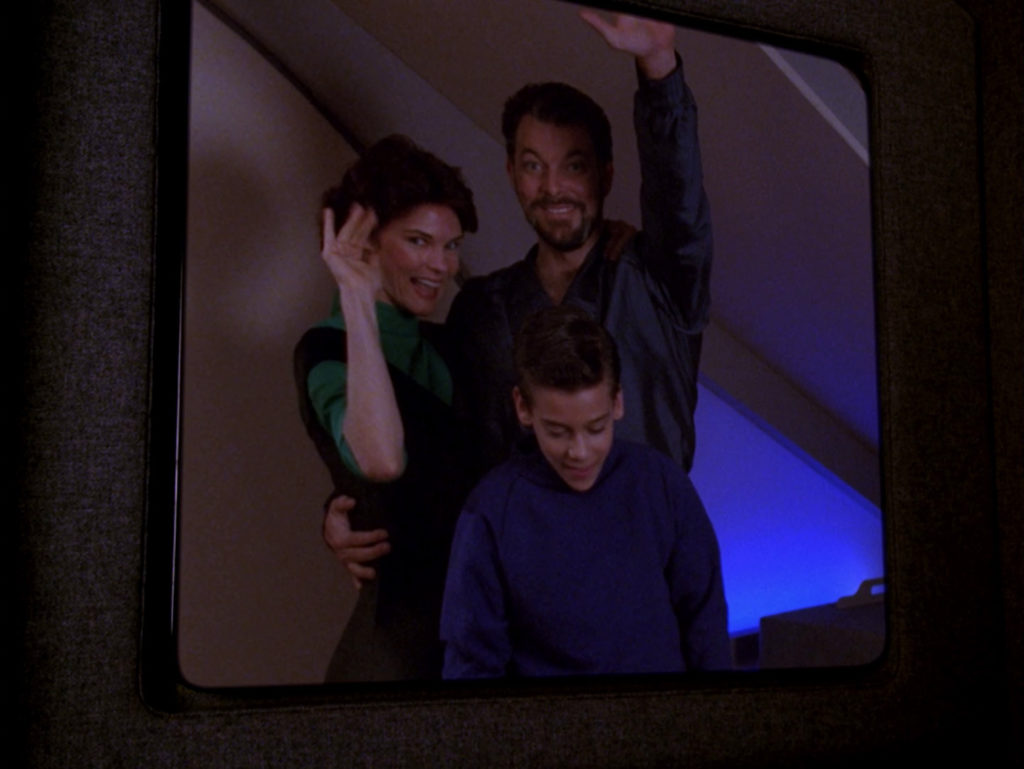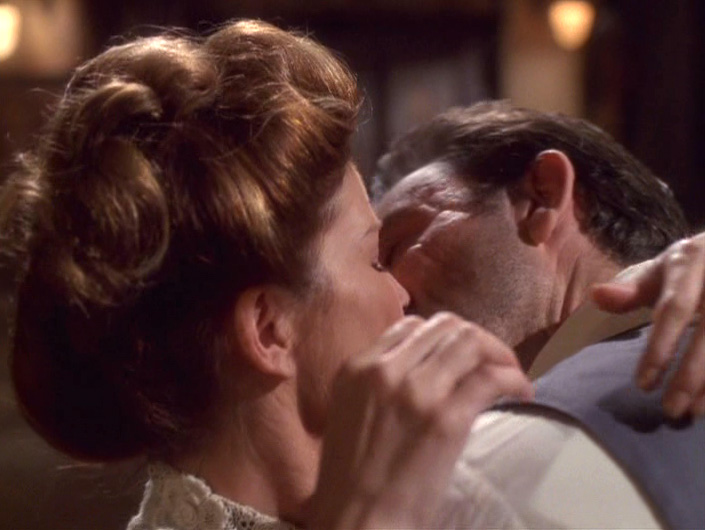 Holographic environment simulators, or holodecks, are spaces of exploration and experimentation. Characters across the Star Trek universe utilize holotechnology for entertainment, investigative, training, and romantic purposes. What, then, can we learn from the love stories created and, in some cases, ended on holodecks? While these techno-romances might seem fantastical, human-hologram relationships can show us the importance of love beyond the corporeal, particularly in our increasingly technologically-dependent world.
Holographic environment simulators, or holodecks, are spaces of exploration and experimentation. Characters across the Star Trek universe utilize holotechnology for entertainment, investigative, training, and romantic purposes. What, then, can we learn from the love stories created and, in some cases, ended on holodecks? While these techno-romances might seem fantastical, human-hologram relationships can show us the importance of love beyond the corporeal, particularly in our increasingly technologically-dependent world.
Riker and Minuet
In Season 1, Episode 15 of The Next Generation, Commander William Riker meets a woman named Minuet. The scene is a quintessential meet-cute: “Isn’t It Romantic?” by Richard Rodgers and Lorenz Hart plays in the background of a dimly-lit jazz club. “What’s a knockout like you doing in a computer-generated gin joint like this?” Riker asks, and Minuet responds in perfect rhythm: “Waiting for you.” (“11001001”). In typical Star Trek fashion, not everything is as it appears: Minuet, like her surroundings, is a figment of the computer. In fact, Riker initially sets the scene to his liking, which includes dictating Minuet’s “sultry” appearance. Riker insists that “blondes and jazz seldom go together” and, therefore, Minuet is altered to fit his preferences, appearing before him with a dark shade of auburn hair.
Minuet, by all accounts, is a tragically underdeveloped character. While Riker appears upset by their parting—even trying to recreate her at the episode’s conclusion—Minuet is nonetheless introduced to the audience as a figure of (holographic) desire, made to reflect Riker’s sexual preferences. Minuet appears via flashbacks in the Season 2 episode “Shades of Gray” before returning in the Season 4 episode “Future Imperfect,” playing wife to Will and mother to their child, Jean-Luc. In comparison to her initial appearance in Will’s holographic recreation of a New Orleans jazz club, Minuet or “Min” is now the maternal figure who died too soon.

Despite her enormous potential, Minuet exists solely as the holographic love interest who is never more than an interesting plot device, yet another synthetic woman who is too good to be true. Minuet is one of many hyperfeminine artificial women in the Star Trek universe, including android Rayna from The Original Series, who was pushed to self-destruction by the actions of Flint and Captain Kirk, as well as Andrea, a gynoid programmed to please her male creator, Korby. Ultimately, Minuet is relegated to the role of one-dimensional love interest for a leading male character, and it is through this role that she is forever etched in the Star Trek canon, not unlike the other synthetic women who came before her.
Janeway and Michael
If Minuet is bound by her association with masculine desires, can featuring a male hologram as a leading female character’s love interest change anything? An answer can be found in Fair Haven, a holographic recreation of a nineteenth century Irish countryside that becomes a getaway for the Voyager crew. Much like Riker’s personal New Orleans, the crew finds comfort in Fair Haven and, like Minuet, the townspeople’s impact on the crew lingers even after the ship’s computer has ended the program.

In her visit to Sullivan’s Public House, Captain Kathryn Janeway meets the owner, a hologram named Michael Sullivan. Janeway soon finds herself interested in Michael; there are, however, a few alterations she makes to his character. Unlike Riker, Janeway first focuses on Michael’s intellect, requesting the computer to give him “the education of a nineteenth century third-year student at Trinity College” before moving on to his personality, wanting him to be “more outspoken, more confident, not so reserved” and “more curious about the world around him” (“Fair Haven”). Janeway moves on to Michael’s appearance, increasing his height and altering his facial hair. In her final touches, Janeway decides to make Michael a bachelor, delivering one of my favorite lines of the series: “Delete the wife.”
Similar to other Fair Haven residents, Michael sometimes veers into the territory of an Irish stereotype, a recurring issue for Star Trek (see: TNG’s “Up the Long Ladder”). Nevertheless, the presentation of Michael as a brooding, handsome pub owner who enjoys reading Irish poetry near the local train station reflects the typical leading man persona, hologram or not. Unlike Minuet, however, Michael is given a backstory: notable hobbies, interests (romantic and otherwise), and even a last name, something Minuet is not provided until she becomes a Riker. He is also shown to encapsulate a wide range of emotions, described as a “broken-hearted hologram” when Janeway leaves him after their romantic date. In a heart-to-heart with The Doctor—the Emergency Medical Hologram on Voyager—Janeway is forced to confront her feelings for Michael, as well as her anxieties around falling for someone without a corporeal form. Voyager, unlike TNG’s treatment of Minuet, makes a point to talk about human-hologram relationships beyond what holograms can do for the humans aboard.
Love beyond corporeality is also seen in the unrequited feelings held by The Doctor for Seven of Nine, as well as the numerous holographic women Harry Kim falls for in his adventures on the holodeck. Still, the connection between Michael and Janeway, as flawed as it is, remains one of the romantic highlights of the series.
Real Synthetic Love
So, what can we take away from the human-hologram relationships portrayed on Star Trek? To start, it is important to remember that humans are already engaging in various forms of techno-intimacies, including the usage of popular dating apps, as well as relying on virtual modalities such as Facetime, Skype, or Zoom to see the people we love. Virtual dating, too, is already taking place, particularly at the height of the global pandemic. Despite futuristic notions associated with technology-based romance(s), humans are already falling in and out of love with non-corporeal versions of others.
Ultimately, both of these human-hologram relationships were doomed from the start. As soon as Riker created Minuet, unabashedly molding her to his desires, the relationship was inherently unequal. Likewise, Janeway’s alterations—no matter how different from Riker’s stereotypical, masculine demands—meant Michael had to live up to her romantic ideals, to the dream partner living in her head. By uncritically placing their emotional, physical, and sexual expectations on Minuet and Michael, both Riker and Janeway lost an opportunity for real love beyond the corporeal. It is up to us, then, to remember the lessons—both good and bad, sexist and not—from Star Trek as we continue to navigate non-corporeal romances and, if we are fortunate enough, love.